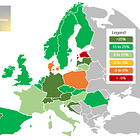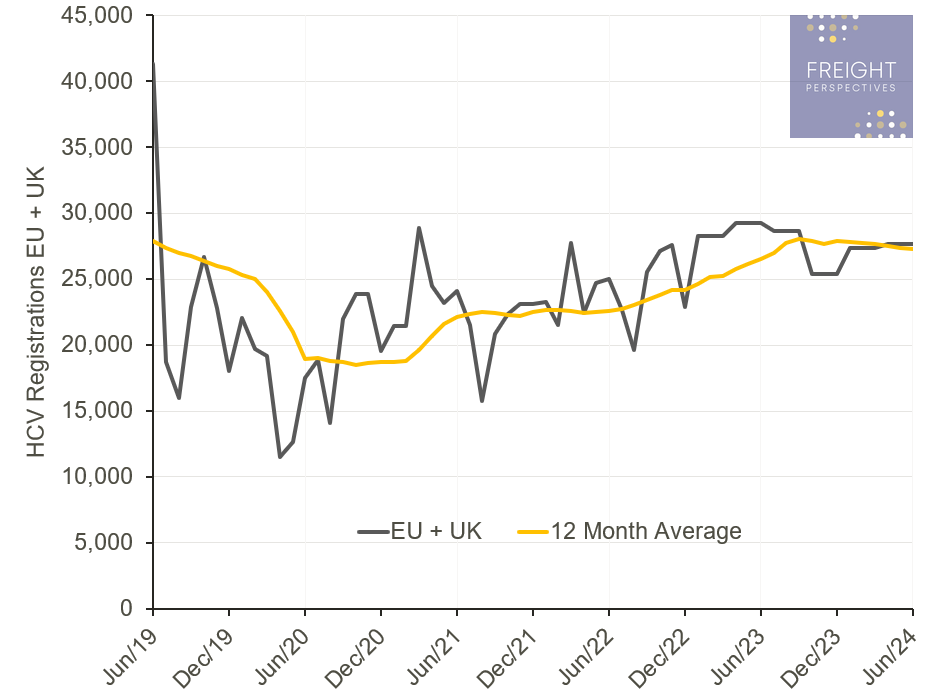Heavy Truck Registrations in Europe remain High
Market Monday - Week 33 - High Registration Figures don't Guarantee Fleet Increase - Update
6 months ago, I shared my analysis and perspective on the near-record-high registration figures for heavy trucks across Europe in 2023.
Now, the latest Q2 statistics paint a slightly different picture. The era of consistent increase in registration figures halted, signaling a potential trend in change. The following map shows the change in registrations from the first half of 2023 to the first 6 months of 2024. An overall decrease in registrations can be derived, with a geographical pattern highlighting Central and Eastern European countries experiencing the most significant drops.
New heavy truck registrations first half 2024 vs. first half 2023
Source: ACEA, own illustration
Norway, Spain, Italy and Austria besides others continued the upward trend with significant registration increases. In contrast, the Baltic countries, Sweden and Slovakia show large decreases, suggesting carriers are limiting fleet modernization due to their changed financial situation. But also France, the United Kingdom, Poland, Hungary and Czechia demonstrated a significant drop in new truck registrations.
The chart below shows that European registrations reached their peak in Q2 2023. Given the near-record-high new registrations of heavy trucks in 2023, a technical decrease seems logical. Although some countries show increases compared to the first half of 2023, overall all markets reveal a 4,4% decline compared to the same period of the previous year.
Heavy truck registrations in the past 5 years
Source: ACEA, own illustration
In my previous articles, I identified two main reasons for the remarkably high registrations in 2023.
A time shift between investment decision and market entry.
An increase in registrations before significant regulatory or technological changes, as seen in the past.
The first point`s relevance seems to be gradually diminishing. The backlog of new truck orders should be processed, with truck manufacturers like Daimler Truck stating that 2023 was an exceptionally good year. However, they expect a return to normal demand this year. The second point likely still impacts, keeping registration figures high compared to other years with a comparable economic situation.
Remarkably, 2024 registration figures are still above most other first 6 months in the past five years and clearly indicate a persistent trend of high registrations.
For the coming quarters we can expect further drops in HCV registrations, especially for diesel engine trucks. Alternative engine registrations may further increase, but their current overall share for Europe remains limited - battery electric vehicles (BEV) accounted for only 1.1% of total registrations in 2024 although they increased by 61,4% compared to the first half of 2023..
Summary
The high overall registrations in 2023 and still elevated 2024 figures don't necessarily indicate a proportional increase in the available fleet. Given the driver shortage and the overall economic situation, we are likely seeing an ongoing fleet modernization rather than enlargement. Reliable de-registration figures are not available and some press releases and financial statements mention fleet decreases and driver shortages. For these reasons we even can’t rule out a decrease in the available fleet.
Despite latest figures, we can still expect registrations of electrified trucks to rise rapidly, as new models enter the market in 2024. Also more shippers will conclude their research on potential areas for e-truck implementation and begin pilot operations.
These high registrations seen won’t prevent the market from demand fluctuations. If demand picks up again, we will likely see capacity shortages and high spot rates.
Christian Dolderer
Lead Research Analyst







